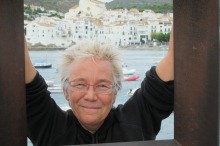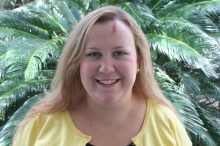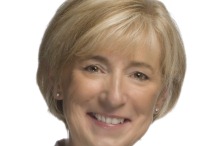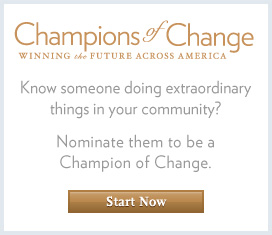Champions of Change Blog
Be Prepared: Helping Communities Bounce Back After Disasters
Posted by on September 14, 2012 at 11:37 AM EDT Nan Buzard is being honored as a Champion of Change for her service to the American Red Cross.
Nan Buzard is being honored as a Champion of Change for her service to the American Red Cross.
What a wonderful surprise – and great honor - to be recognized as a White House Champion of Change on behalf of the American Red Cross. I lead the American Red Cross’ response to disasters around the world. Over the past seven years, it has been deeply satisfying to see our increased investment in preparedness, risk reduction and resiliency throughout our global programs. Disasters will always happen but families and communities can better withstand and recover if provided with preparedness opportunities ahead of time.
When you see the enormous toll disasters take – especially on highly vulnerable populations – you know we need to make larger investments in preparedness. Of course we can’t protect everyone from everything – but I have seen what better preparedness can accomplish and it is definitely worth serious focus and increased resources.
Directly following the March 2011 tsunami, the Japanese Red Cross asked me to join them in assessing their response and recovery operations and options. It was a profoundly sobering experience to see the destruction of hundreds of miles of coastline, with shattered villages and lives.
Learn more about ServiceCreating Community Resilience
Posted by on September 14, 2012 at 11:23 AM EDT Monica Owens is being honored as a Champion of Change for her service to the American Red Cross.
Monica Owens is being honored as a Champion of Change for her service to the American Red Cross.
I am truly humbled and honored to receive recognition as a Champion of Change. My first lessons regarding the importance of service to both the nation and local communities came observing my parents. My father is retired from the United States Air Force and my mother has dedicated her life to working in public education, often in very challenging school districts. Both of my parents have been involved in community work around the world especially through faith-based networks. At a young age, I was exposed first hand to the mission of the American Red Cross. In 1994, flooding devastated my hometown of Warner Robins, Georgia. I will never forget helping my extended family members during the recovery process.
Learn more about ServiceSaving Lives On and Off the Job
Posted by on September 14, 2012 at 11:07 AM EDT Mahogany Thomas is being honored as a Champion of Change for her service to the American Red Cross.
Mahogany Thomas is being honored as a Champion of Change for her service to the American Red Cross.
I am honored and humbled beyond words to represent the U.S. Probation Office in Los Angeles, California and the American Red Cross as a White House Champion of Change. Several years ago, I enrolled in a leadership class that challenged me to find out who I am, what drives me to succeed, and what might bring balance and fulfillment to my life. Somewhere in this process, I had an epiphany that shaped my career and personal life. I recognized that my life worked so much better when I was focused on helping others.
Around the same time, I also became aware of the American Red Cross blood program and the constant need for blood donations. I learned that hospitals and trauma centers trust the Red Cross to deliver lifesaving blood for accident victims, sick children, and cancer patients. I learned that there is no substitute for human blood -- no synthetic liquid, wonder drug or state-of-the-art device capable of replacing a pint of donated blood. I learned that each year, hundreds of thousands of Southern California hospital patients depend on healthy blood donors for their second chance. I also learned that the #1 reason that people do not donate, is because they are not asked.
Learn more about ServicePreparing Our Communities Must Start Long Before Disaster Strikes
Posted by on September 14, 2012 at 10:29 AM EDT Kay Wilkins is being honored as a Champion of Change for her service to the American Red Cross.
Kay Wilkins is being honored as a Champion of Change for her service to the American Red Cross.
I am very honored to be selected by the White House as a Champion of Change. As part of the Southeast Louisiana Red Cross Chapter headquartered in New Orleans, I have learned first hand how critical it is for everyone to be ready for emergencies, and know from my experiences that preparation must start long before the disaster begins.
For more than 25 years, through various posts including Director of Emergency Services and my present position as Chief Executive Officer for the South Louisiana Region, I have helped our chapter respond to many disasters, including the worst natural disaster to strike this country in decades, Hurricane Katrina. And even now, we are responding to Hurricane Isaac, offering those families affected by this storm, shelter, food and a shoulder to lean on.
Large disasters leave massive devastation in their wake and trigger a fear of the unknown in those affected, a fear of what is to come. We see that fear on the faces of those coming to us for help and comfort.
In the initial days of our response to Katrina, while some people came to our shelters with supplies, hundreds more did not. They were brought to us with nothing more than what they could carry as they were hoisted into a boat or rescued from a rooftop by helicopter. They were truly the walking wounded. Fear and anxiety had become their norm. Many were thankful just to be alive. Seeing the distress these emergencies cause has prompted me to work in our communities, to educate each individual about what they must do to be ready for that next emergency.
Learn more about ServiceUsing Digital Technology To Prepare People for Disaster
Posted by on September 14, 2012 at 10:12 AM EDT Dom Tolli is being honored as a Champion of Change for his service to the American Red Cross.
Dom Tolli is being honored as a Champion of Change for his service to the American Red Cross.
I am honored to be recognized as a White House Champion of Change on behalf of the American Red Cross. Our team, composed of people and developers inside and outside the Red Cross, in a very short amount of time accomplished something that will enable people, businesses and schools to drastically improve their ability to respond to, survive and bounce back from a disaster or medical emergency. Having been involved with high tech companies and startups over the last 15 years, I have seen how hard work, brilliant talent and dedication can forever change the landscape.
The American Red Cross has a long and proud history of preventing and alleviating human suffering in the face of emergencies. Traditionally, much of the prevention work was done through human interactions at the numerous chapters and volunteers throughout the Red Cross. Digital and mobile technology drastically expands this human interaction and enables people to receive critical information when they need it, where they need it and how they need it.
Mobile devices represent a big opportunity to reach individuals and their families with critical lifesaving information and services. It is the age of cell phones and tablet computers. People of all ages depend on them to keep in touch, to stay informed. These devices are as much a part of life today as important inventions of the past like the automobile and television. As technology has advanced, it is important that the Red Cross move forward too.
Our mobile apps are an important new way to help more people stay safe and know what to do if a crisis occurs. To get critical first aid information into the hands of consumers, my team launched the free First Aid app. To help those in hurricane prone areas or for those with families in those areas, we launched the free Hurricane mobile application. Hundreds of thousands of people downloaded that app as Hurricane Isaac approached the Gulf coast, putting critical weather alerts and preparedness information in their pockets just in the nick of time. These two apps are just the first in a series of the Red Cross plans to release over the next several months.
But it’s not just about getting families and indivduals prepared. Ready Rating is an online program targeting small to medium size businesses and schools with the goal to drastically improve their level of preparedness. Through the generosity of Anheuser-Busch and other corporations, an online service was developed which enabled companies and schools to use a tool to measure their level of preparedness. Being able to actually measure this was quite a breakthrough. Initial users rated the program as an excellent tool and 75 percent took actions to improve their level of preparedness.
The Ready Rating team then expanded the program to include key additional services such as a Next Steps Report which gives the user specific steps and efforts required for a company or school to improve their preparedness level. The Emergency Response Tool Planner enables customers to create a customized emergency plan for their company or school, and a new user experience makes it easier than ever for customers to sign up and use the service. The results continue to be outstanding with nine out of ten customers becoming the most prepared in their industry, recommending this service to other companies.
And we are not done. We plan to aggressively grow the membership of Ready Rating customers and introduce more mobile applications. The bedrock of resilient communities is resilient consumers and resilient businesses and schools. Ready Rating and the Red Cross mobile apps provide the foundation upon which we and others can build.
We here at the Red Cross work year round to make sure our organization is prepared for disaster, whether it is a small, single-family fire or large disaster like a flood or hurricane. Our efforts to use modern technology to help everyone get ready for emergencies are vital to support the country’s ability to respond when the next disaster strikes.
Dom Tolli leads American Red Cross teams that develop and implement new services to help people and organizations be prepared for emergencies
Learn more about ServicePutting a Face on Blood Donations
Posted by on September 14, 2012 at 9:55 AM EDT Brian Boyle is being honored as a Champion of Change for his service to the American Red Cross.
Brian Boyle is being honored as a Champion of Change for his service to the American Red Cross.
My name is Brian Boyle, I am 26 years old, and I am a blood recipient. I am honored to be recognized as a White House Champion of Change on behalf of the American Red Cross.
Eight years ago, on July 6, 2004, I was involved in a near fatal car accident that caused catastrophic injuries. My heart was pushed across my chest, crushed pelvis, shattered ribs, broken clavicle, collapsed lungs, every major organ was damaged, and I lost 60% of my blood. My blood donors were the foundation of my recovery. When I arrived at Shock Trauma by medevac, I received 36 blood transfusions and 13 plasma treatments, underwent 14 life saving operations, and would spend the next two months in a medically induced coma on life support. I eventually awoke from the coma and after intensive rehabilitation, I learned how to blink, move my fingers, talk, eat, sit upright, stand, walk, and then swim, bike, and run.
Three years after leaving the Intensive Care Unit, I completed the healing process when I crossed the finish line in the Ironman World Championship in Hawaii – the greatest day of my life.
I made a promise to myself when I was in rehab that I would give back to the Red Cross to help other patients the first opportunity I had. For the past five years I have travelled across the nation speaking at Red Cross events, hosting blood drives and acting as a national spokesperson to illustrate the crucial need for blood. I also participate in marathons and triathlons on behalf of the Red Cross. This year, I completed the Boston Marathon and New York City Ironman. In October, I'll compete in the Hartford Marathon, each time wearing the Red Cross emblem on the front and back of my suit. Lastly, I use social media to promote the Red Cross to my more than 3,500 followers. I find it is a great way to keep the discussion about the need for blood alive and it encourages others to support the Red Cross by donating blood, volunteering their time or making a financial contribution.
Learn more about Service
- &lsaquo previous
- …
- 89
- 90
- 91
- 92
- 93
- 94
- 95
- 96
- 97
- …
- next &rsaquo

